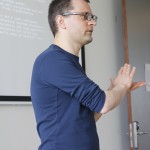
A preliminary proposal for the Digital Publishing Toolkit
by Florian Cramer
The Toolkit should contain two basic elements. On the one hand a “Howto Document” as a sort of manual, and on the other a “Software Toolkit” should be compiled off both existing and self-written utilities.
PART 1 – A “HOWTO DOCUMENT”
CONTENT
The “Howto Document” should not presuppose any technical knowledge, but become an “e-publishing DIY for dummies”. It should become an empowerment document in an accessible language providing cultural sector publishers the know-how to produce e-publications. For this reason the manual should be released both as an analog and a digital publication. The target group of this project are mostly still in the analog world and this publication should help them to make the step to the digital world. The readers of the document will be: book publishers, magazine publishers, writers, editors, artists, graphic/media designers.
SCENARIOS: Several scenarios should give insight in the different possibilities of e-publishing in relation to different circumstances and contexts. A proposed set of these scenario’s: visual publications, research publications, periodicals, new types of publications.
TECHNOLOGY: Departing from this introduction a technological overview of pros and cons of – websites, PDF, mobile apps, EPUB2/mobi, EPUB3/html5/iBook/KF8 – is needed. But also an overview of the strengths and limitations and the differences between reader software, reader hardware and different file formats. This document will be out of date in a few years, but it is still necessary to create such an overview.
WORKFLOWS: The problem that likely needs to be communicated the most is the change in workflows. As a publisher you cannot work the old way – using InDesign or other print oriented documents as the departure point for you e-publication. This shift should be explained per scenario with an emphasis on practical solutions.
DISTRIBUTION PLATFORMS: The Pros and Cons of distribution platforms, like e-bookstores (Amazon, Apple, Google, Kobo, Sony), online reading (Scribd , Issuu…), print-on-demand, pirate platforms (AAAAARG, Monoskop, PirateBay), artist- / designer-run projects (Badlands, KYUR8, artistsebooks) also need to be discussed.
GUIDE: DESIGN YOUR OWN E – PUBLICATION: Eventually a guide will be developed that addresses per scenario the change in workflow and indicate ‘for which part you need what’. Presumably it should focus on EPUB2/3, with an emphasis on EPUB3. It needs to provide a step – by – step guide clarifying that publishers need to work from well-structured sources (not from PDF, InDesign or Word documents, but ideally XML-based documents or more pragmatically, documents in a lightweight semantic markup language like MultiMarkdown) to a final publication. It should focus on new, relevant insights: Everything that is covered elsewhere needs to be left out and addressed by a short summary. For instance Elizabeth Castro’s book “EPUB straight to the point” on transforming Word and InDesign documents to EPUB already addresses the pitfalls of working from InDesign, and this should not be explained in great depth in this manual. Also the results that are too case-specific should be left out. Cases where you really need an external professional should be clearly indicated as such, and skipped as well.
FLOWCHARTS: Each workflow should also be visualized in easy-to-follow flowcharts for each scenario.
SUMMARY: The summary should sum up common pitfalls, technological shortcomings and new opportunities.
FUTUROLOGY: Finally a vision for the future will try to answer ‘Where will we be in 2020..?’ What will the reading technology, the reading culture, the publishing culture look like, what do we expect the industry and the market to look like.
APPENDIX: This should contain a glossary of technical terms, key word index, bibliography, and a link list.
FORM OF THE DOCUMENT (We will eat our own dog food!)
The developed workflows will determine how this publication will be approached: The source format will be MultiMarkdown and the publishing formats will be: Website / HTML, EPUB, HTML5 app (?), PDF, print book. Thus developing a publication for each format based on a well-structured source format.
PART 2 – SOFTWARE TOOLKIT
CONTENT: As explained, the software toolkit will exist both of existing software and self-written software. The existing utilities should be mainly based on open source tools, but essentially there should be a detailed overview of tools that are vital and necessary for e-publishing. This could also include restricted freeware and/or proprietary tools as long as they have something unique to offer and are worth the financial investment. With regards to the self-written software, the emphasis should be on simple, reusable code, small tools that fix common problems. These should all be in the public domain or released under an open source license.
FORM: The existing software should be referenced within the workflows, but also separately in the manual with URLs. A list of links to all these tools should be compiled as a website repository and should be regularly maintained (for example, twice a year through a student assistant). The self-written software should be part of this website repository and the source codes should be included in the published manual where possible.
DISTRIBUTION: The distribution of this “Digital Publishing Toolkit” should address all possible platforms: All book stores, all online reading platforms, all pirate sites, all artist-run sites, our own website, etc.
MONETIZATION: There should be an overview of the most relevant platforms and systems for payment/compensation. This will not be an overview of business models, but simply technical information on the payment systems that are available.


